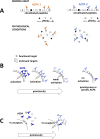Current view on the pathogenic role of anti-citrullinated protein antibodies in rheumatoid arthritis
- PMID: 33771834
- PMCID: PMC8006837
- DOI: 10.1136/rmdopen-2020-001228
Current view on the pathogenic role of anti-citrullinated protein antibodies in rheumatoid arthritis
Abstract
Epidemiological findings suggest a potential role for anti-citrullinated protein antibodies (ACPAs) in rheumatoid arthritis (RA) pathogenesis. ACPA-positive RA is associated with unique genetical and environmental risk factors, in contrast to seronegative RA. ACPA-positive healthy individuals are at risk of developing RA and can develop joint pain and bone loss already before disease onset. ACPA injection triggered bone loss and pain-like behaviour in mice and, in the presence of additional arthritis inducers, exacerbated joint inflammation. In cell culture experiments, ACPAs could bind to and modulate a variety of cellular targets, such as macrophages, osteoclasts, synovial fibroblasts, neutrophil granulocytes, mast cells, dendritic cells and platelets, further underlying a potential role for these autoantibodies in triggering pathogenic pathways and providing clues for their mechanisms of action. Patient-derived ACPA clones have been characterised by unique cellular effects and multiple ways to act on the target cells. ACPAs might directly induce stimulatory signals by ligating key citrullinated cell surface molecules or, alternatively, act as immune complexes on Fc receptors and potentially other molecules that recognise carbohydrate moieties. On the contrary to experimentally manufactured ACPA clones, patient-derived ACPAs are highly promiscuous and cross-reactive, suggesting a simultaneous binding to a range of functionally relevant and irrelevant targets. Moreover, several ACPA clones recognise carbamylated or acetylated targets as well. These features complicate the identification and description of ACPA-induced pathogenic mechanisms. In the current review, we summarise recent data on the functional properties of patient-derived ACPAs and present mechanistic models on how these antibodies might contribute to RA pathogenesis.
Keywords: anti-citrullinated protein antibodies; arthritis; autoimmunity; rheumatoid.
© Author(s) (or their employer(s)) 2021. Re-use permitted under CC BY-NC. No commercial re-use. See rights and permissions. Published by BMJ.
Conflict of interest statement
Competing interests: None declared.
Figures



Similar articles
-
Different Hierarchies of Anti-Modified Protein Autoantibody Reactivities in Rheumatoid Arthritis.Arthritis Rheumatol. 2020 Oct;72(10):1643-1657. doi: 10.1002/art.41385. Epub 2020 Sep 10. Arthritis Rheumatol. 2020. PMID: 32501655
-
Anticitrullinated protein antibodies facilitate migration of synovial tissue-derived fibroblasts.Ann Rheum Dis. 2019 Dec;78(12):1621-1631. doi: 10.1136/annrheumdis-2018-214967. Epub 2019 Sep 3. Ann Rheum Dis. 2019. PMID: 31481351 Free PMC article.
-
Anti-Citrullinated Protein Antibody Reactivity towards Neutrophil-Derived Antigens: Clonal Diversity and Inter-Individual Variation.Biomolecules. 2023 Mar 31;13(4):630. doi: 10.3390/biom13040630. Biomolecules. 2023. PMID: 37189377 Free PMC article.
-
Anticitrullinated protein antibodies: origin and role in the pathogenesis of rheumatoid arthritis.Curr Opin Rheumatol. 2017 Jan;29(1):57-64. doi: 10.1097/BOR.0000000000000356. Curr Opin Rheumatol. 2017. PMID: 27755123 Free PMC article. Review.
-
The current status of anti-citrullinated protein antibodies and citrullinated protein-reactive B cells in the pathogenesis of rheumatoid arthritis.Mol Biol Rep. 2022 Mar;49(3):2475-2485. doi: 10.1007/s11033-021-07034-0. Epub 2021 Dec 2. Mol Biol Rep. 2022. PMID: 34855107 Review.
Cited by
-
Fc Proteoforms of ACPA IgG Discriminate Autoimmune Responses in Plasma and Synovial Fluid of Rheumatoid Arthritis Patients and Associate with Disease Activity.Adv Sci (Weinh). 2025 Apr;12(15):e2408769. doi: 10.1002/advs.202408769. Epub 2025 Feb 22. Adv Sci (Weinh). 2025. PMID: 39985219 Free PMC article.
-
Impaired Periodontitis-Induced Cytokine Production by Peripheral Blood Monocytes and Myeloid Dendritic Cells in Patients with Rheumatoid Arthritis: A Case-Control Study.J Clin Med. 2024 Sep 6;13(17):5297. doi: 10.3390/jcm13175297. J Clin Med. 2024. PMID: 39274511 Free PMC article.
-
Neutrophil extracellular traps in systemic autoimmune and autoinflammatory diseases.Nat Rev Immunol. 2023 May;23(5):274-288. doi: 10.1038/s41577-022-00787-0. Epub 2022 Oct 18. Nat Rev Immunol. 2023. PMID: 36257987 Free PMC article. Review.
-
ACPA-CD147 axis in the NLRP3 inflammasome of RA macrophages.Cell Mol Immunol. 2022 Aug;19(8):957-959. doi: 10.1038/s41423-022-00889-8. Epub 2022 Jun 22. Cell Mol Immunol. 2022. PMID: 35729222 Free PMC article. No abstract available.
-
An update on autoantibodies in the idiopathic inflammatory myopathies.Nat Rev Rheumatol. 2025 Jan;21(1):46-62. doi: 10.1038/s41584-024-01188-4. Epub 2024 Nov 28. Nat Rev Rheumatol. 2025. PMID: 39609638 Review.
References
-
- Hensvold AH, Magnusson PKE, Joshua V, et al. . Environmental and genetic factors in the development of anticitrullinated protein antibodies (ACPAs) and ACPA-positive rheumatoid arthritis: an epidemiological investigation in twins. Ann Rheum Dis 2015;74:375–80. 10.1136/annrheumdis-2013-203947 - DOI - PubMed
Publication types
MeSH terms
Substances
LinkOut - more resources
Full Text Sources
Other Literature Sources
Medical
